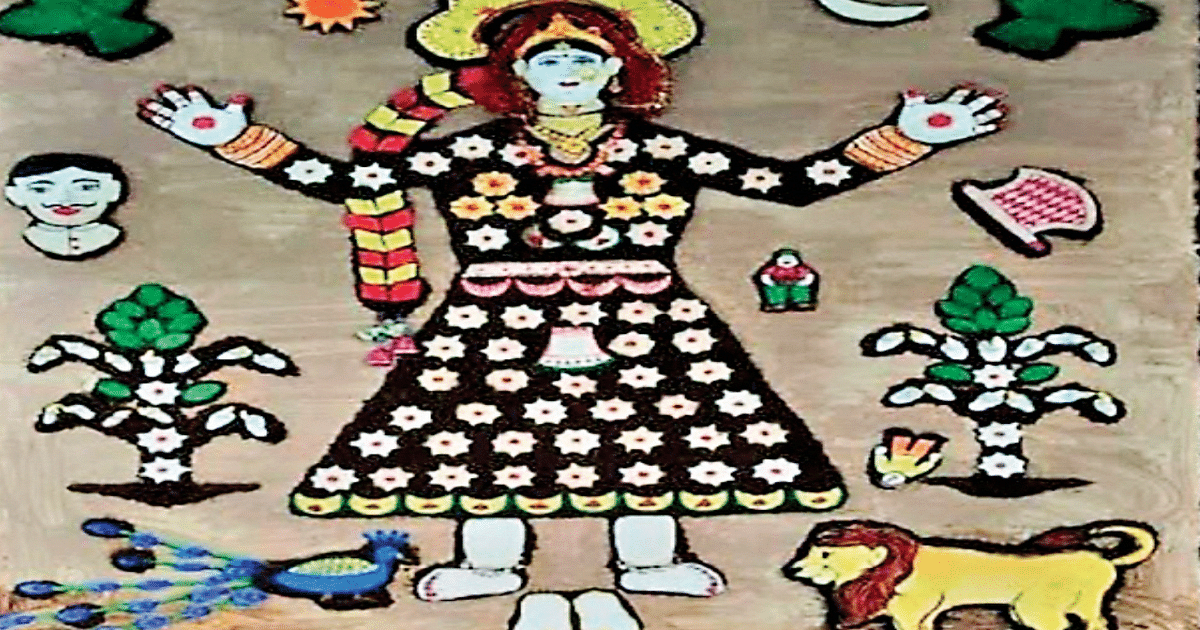Asha Sharma
Pitru Paksha occurs from Krishna Pratipada to Amavasya in the month of Ashwin. During these 15 days, people offer prayers to their ancestors and gods and perform Shraddha and donate money on the date of their death. During this period, the tradition of presenting Sanjhi art attractively is followed in the major temples of Mathura and Vrindavan. On this occasion, artistic Sanjis are prepared in temples using flowers, colours, threads, cow dung and water.
While preparing the mixture of colours, artistic vines are prepared by sifting the dried colors through small cotton cloth bundles and moving the colors with the fingers. There is an old tradition of Sanjhi Manorath in the temples like Radhaballabh Temple of Vrindavan, Bhattji Ki Haveli, Radharaman, Gopinathji Temple, Shahjahanpur Temple, Priyaballabh Kunj and Yashodnandan Temple, which is also being followed by today’s young generation. The word Sanjhi is derived from ‘Saanjh’. Saanjh means evening time or Sandhya which is prevalent in Braj.
Sandhya means sandhikaal – the time between evening and night. Shyamsundar along with his cowherds goes to graze cows every morning and returns in the evening. Therefore, this time of evening is divine. After touching the feet of Krishna, Balram and the cows along with her friends, even Braj Raj becomes proud and starts flying in the sky. Therefore, this evening time has also been named “dusk”. Due to the depiction of this art at this time, it got the name ‘Sanjhi’. Sanjhi is a wonderful folk art. The charming scenes of Shri Krishna Leela decorated in various geometrical shapes through various colours, a unique art of Braj, after seeing which one is reminded of Shri Krishna Leela.
This art made extensive progress during the Bhakti movement in the 16th century. Vaishnav temples are still keeping Sanjhi art alive. In Braj, this art has special divinity due to its connection with Shri Krishna Leela. It is believed that the first Sanjhi was made by Shri Radharani with the Gopis. Since it is a replica of the art made by Radha, this Sanjhi is considered as the deity and is worshiped in Braj. ‘Whatever you do, get the desired results. Listen to this Sanchou Dev of Kunwari Vrishabhanu.’
The tradition of Sanjhi in the singing style of temples is not only an artistic beauty, the singing of the verses associated with this tradition further enhances its importance. According to the worship tradition in the Radhaballabh sect, Leelas are recited during Sanjhi, while as part of community singing, verses composed by various singers are sung in the evening. Gopal Sharan Sharma, publishing officer and litterateur of Braj Culture Research Institute in Vrindavan, says that Sanjhi is a wonderful craft of Braj popular as a folk ritual.
It is celebrated with full rituals. In fact, coordination of painting, singing and worship is seen in Sanjhi art. Sanjhi’s verses are found in devotional literature and songs and Sanjhi’s songs are found in folk literature. Sanjhi’s verses are sung in temples. In villages, girls worship ‘Sanjha Mai’ by singing songs. From the point of view of painting, a unique combination of artists’ imagination and combination of colors, nature depiction etc. can be seen in Sanjhi. The story of Sanjhi’s fast reflects its worship rituals. Here, the Sanjhi fair of Brahmakund is regaining its glory.
(Assistant Professor IMS, Noida)

